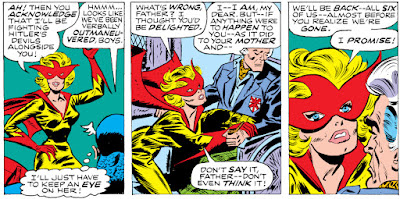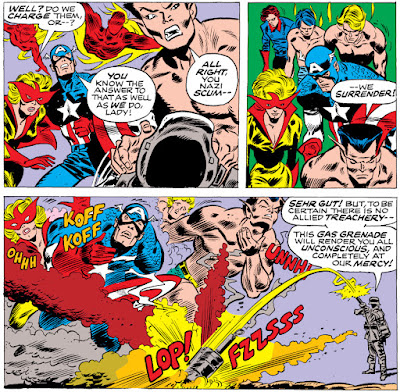"TO THE WARSAW GHETTO!"
Writer/Editor: Roy Thomas | Illustrators: Frank Robbins & Frank Springer
Colorist: Phil Rache | Letterer: Joe Rosen
Writer/Editor: Roy Thomas | Illustrators: Frank Robbins & Frank Springer
Colorist: Phil Rache | Letterer: Joe Rosen
The Plot: The Human Torch flies over London, despondant over Jacqueline's obvious feelings for Captain America. As he passes the Tower of London, where Professor Gold is being held following his rampage as the Blue Bullet, the Torch decides to pay the professor a visit and question him about his comment that what happens next will be on the Invaders' heads. In his cell, Gold says that he worked for the Nazis unwillingly. He is a Polish Jew who fled the Nazi occupation to become an Allied scientist -- but the Nazis found him and forced him to do their bidding, lest they kill his brother, who remained behind in Warsaw.
The Torch returns to Falsworth Manor to recruit the Invaders in rescuing Gold's brother. Jacob. The group, now counting Jacqueline in the guise of Spitfire among them, boards Namor's flagship and flies to Poland. Under cover of night, they inflitrate the ghetto to find Jacob in his book shop. But the Invaders run afoul of Nazi soldiers, who call in a few Panzer tanks as backup. The heroes make short work of two tanks, but when the third tank's commander threatens to kill Jacob and several other civilians, the Invaders are forced to surrender, and are taken away.
Jacob returns to his shop, realizing he must now stop ignoring the Nazis' atrocities and stand up against them to help the Invaders and his own people.
Continuity Notes: The Torch helpfully recaps the events of issues 7 through 11 (which Roy Thomas refers to as "a long night" in a footnote) for readers new and old: As mentioned above, Jacqueline dons a colorful costume and adopts the name of Spitfire to join the Invaders. The group initially pushes back, but after she demonstrates her speed and prowess against them, they relent and allow her to join. (Spitfire's costume has always seemed to me to be the basis for Firestar's costume in the SPIDER-MAN AND HIS AMAZING FRIENDS cartoon series, and later in the Marvel Universe proper. I'm not sure I've ever seen anyone stating this outright as fact and it's possible I'm totally wrong, but the similarities between the two looks vastly outnumber the differences.)
When the Invaders visit Jacob in his bookshop, he tells them the legend of the Golem of Prague. Based on the next issue blurb (see below), this feels like it might become important... At one point, Thomas tosses in a totally gratuitous footnote regarding the respective backstories of the Human Torch and Toro. As I've mentioned many times, I love a good footnote, but sometimes -- especially in the seventies -- writers could go way overboard with them. This is such a case. The footnote adds nothing, the bits referenced are random pieces of backstory and not integral reading, and it just feels overly self-indulgent. My Thoughts: Well, it's really just set-up for the next issue, and there's no colorful antagonist to speak of, so I find it hard to judge this one on its own merits. Look at it this way: this is a seventeen-page story. Of those seventeen, one is the opening splash, two are the Torch's flashbacks to recent issues, and one is Professor Gold telling his backstory. That leaves thirteen pages for the story proper -- which winds up consisting of Spitfire convicing the Invaders to let her join their boys' club, and the Invaders fighting a bunch of common Nazis.
And while it's always fun to see Nazis get beaten up, I'm here for the super-villains, like Master Man, U-Man, Baron Blood, etc. The Invaders, like the Avengers and the Fantastic Four, don't lend themselves well to fighting normal humans. Yeah, there are a few tanks involved, but it's clear that they're no threat whatsoever to this group, and it's only the Nazis threatening innocents that forces our heroes to "lose" the fight. INVADERS isn't like SPIDER-MAN or DAREDEVIL, where the bad guys can just be a bunch of goons in suits or whatever. Unless you're doing a Captain America/Bucky solo outing, this team needs some credible super-powered menaces to fight! But that's just my opinion. I think the entire thing could've been presented differently, with the main "fight" being an extended sequence of Spitfire putting the Invaders through their paces to prove her place among them, followed by a much shorter excursion to Prague with less fighting there.
In any case, it looks like we'll be back to super-stuff next issue, if the ominoous closing scene is anything to go by!










I was always bothered by a kid by the Invaders being knocked out easily by a gas grenade-simply because if it worked, why didn't they try it SOONER?
ReplyDeleteAdult me is now wondering why Namor didn't just dare the Nazis to do it because he's not the nicest of guys and getting him there to rescue a single person was unlikely in the first place.
Adult me also wonders why, if the Invaders could just waltz into Poland without much difficulty, they didn't just go to Berlin, but that's always a problem with superhero stories set during World War II.
To your last point, next week's post is mostly about how the Invaders don't work in a world where the writer is trying to preserve the real-world history of World War 2! I mean, they storm the Warsaw ghetto, easily overcome the German occupation force, and then just leave afterward, basically turning everything back over to the Nazis. It's an overly glaring example of that sort of thing.
DeleteAnd yes -- the Invaders do tend to get defeated in very pedestrian ways sometimes. Particularly Captain America. I (and, I suppose, much of the world) am so used to the Cap whose real super power is that he overcomes all odds and never gets beaten, that it's really weird to read older comics where he was treated basically like a normal guy, getting knocked out by punches and gas and stuff like that on a regular basis.
Yeah, a story set in the Warsaw Ghetto ending in the status quo is a really, really bad choice. World War II superhero stories are always fraught with peril there, but given how things turned out in Warsaw, maybe someone should have thought that through.
DeleteThe thing is, Roy apparently did think it through to some extent! The next issue ends with the Invaders leaving, as narration tells us that they have no way of knowing about the eventual uprising and massacre. It's a really puzzling creative choice.
DeleteFirestar’s costume really is basically Spitfire’s minus the cape. Firebird’s, she of the Rangers and later West Coast Avengers, is quite similar too with just a bit more detail.
ReplyDelete